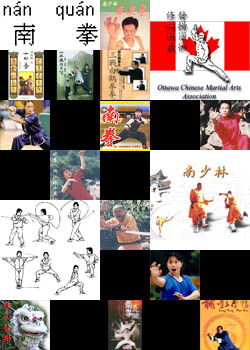
| Home | ||
| About Us | ||
| Overview | ||
| Shaolin | ||
| Hsing Yi | ||
| Tai Chi | ||
| Bagua | ||
| Baji | ||
| Health | ||
|
|
||
| Links | ||
| Directory | ||
| News |
an Quan, Nanquan, 南拳派, Southern Style Boxing or Southern Fist is widely practised in south China. It evolved during the Ming Dynasty (1368-1644) and has many styles.
Nanquan emphasizes squatting stances with a low center of gravity and steady footwork. It is characterized by combinations of short moves with few jumps. Power is generated through breathing and sound articulation.
China can be divided geographically into North and South by the Yangtze River (Changjiang). According to martial arts tradition, the styles practice North of the river are known as Bak Pei (北派) while the fighting style of the South are referred to as Nanquan (南拳). There are numerous traditional styles famous in the South with roots associated with different martial arts families as well as the Southern Shaolin Temple (南少林) and differ according to the geographical region. Martial arts in Fujian, Guangdong, Guangxi, Sichuan, Jiangxi, Zhejian, Jiangsu and other areas have all developed different flavors of martial arts even for styles with the same name. The style evolved during the Ming Dynasty (1368-1644) and played a leading role in the struggles agaisn the Ching Empire. Nanquan has now become an integral part of the modern sport of Wushu in addition to Changquan and Taijiquan. Schools of Nanquan can now be found throughout the world.
Examples of the Southern Styles:
- Five Great Families (五大名家)
- 洪家拳 (Hung)
- 劉家拳 (Lau)
- 蔡家拳 (Choi)
- 李家拳 (Li)
- 莫家拳 (Mok)
- 五祖拳 (Five Ancestor Fist)
- 佛家拳 (Buddha Style)
- 俠家拳 (Hop Gar Quan)
- 刁家教
- 南枝拳
- 南鷹爪 (Southern Eagle)
- 大聖劈掛門
- 太祖拳
- 孔門拳
- 客家 (Hakka)
- 小策打
- 屠龍拳
- 岳家教 (Yeh Family)
- 昆侖拳
- Southern Praying Mantis
- 朱家螳螂 (Chow Gar)
- 東江周家螳螂 (Chu Gar)
- 廣西周家拳 (Kwongsai Chu Gar Praying Mantis)
- 鐵牛螳螂 (Iron Ox)
- Jook Lum
- 柔功門
- 洪佛派 (Hung Fut)
- 湖南的巫家拳
- 白眉拳 (White Eyebrow)
- 白鶴派
- 福建少林 (Fukien Shaolin)
- 練手拳
- 羅漢拳 (Lohan Quan)
- 蔡李佛拳 (Choy Li Fut)
- 薛家拳
- 虎鶴雙形拳
- 蛇形刁手 (Insect shape)
- 西藏喇嘛派
- 詠春拳 (Wing Chun Quan)
- 譚家三展
- 金剛拳
- 關外地蹚門
- 雙龍派 (Double Dragon)
- 青城梅花派
- 魚門拳 (Fish Door Fist)
- 鶴拳
- 黑虎拳 (Black Tiger Fist)
- 龍形派 (Dragon)

he features of nanquan are:
- Features are simple and vigorous
- Stance is low for example in the horse stance
- Footwork is firm and steady
- Force is heavy and violent focusing on the hand or bridges (arms)
- Focus on upper body and intricate arm movements rather then jumps and springs with leg techniques
- An important training technique is the use of appropriate breathing strategies that sometimes incorporates shouts to demonstrate the spirit of the move.
Nanquan has a greater number of styles and each geographic area has its own distinct history and techniques. Nanquan can generally be divided into two different styles: short bridges and long bridges.
The chief characteristics of short bridges styles are:
- Draw the chest in, pull the back up, sink the shoulders, drop the elbow, pull the hip in, stretch the bridges short and squat slightly.
- Force is exerted briefly and at close range
- Range of steps are small
Examples of the short bridges style include: Wing Chun, Southern Praying Mantis, Bak Mei
The chief characteristics of long bridges styles are:
- Throw the chest out, sink the waist, draw the abdomen in, pull the hip in, stretch the bridges out and squat low
- Force is exerted continuously and targeted at mid to far range
- Range of steps are long
Examples of the long bridge styles include: Hung Gar, Choy-Li-Fut, Hop Gar.
Copyright 2004
